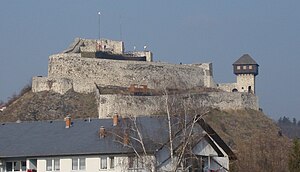Battle of Doboj
| Doboj Fortress | |
|---|---|
| Doboj, Bosnia and Herzegovina | |

Doboj Fortress
|
|
| Coordinates | 44°44′13″N 18°05′17″E / 44.737°N 18.088°E |
Doboj Fortress or "Gradina" is located in the city of Doboj, Bosnia and Herzegovina. The fort is currently abandoned.
One of the most important defenses in the medieval bannate/duchy of Usora, this large stone structure was built in the early 13th century on the site of an earlier, clay and wood-based structure from the 10th or 11th century. In the first period of its existence, from the 13th to the late 14th or early 15th century (1415), the fortress was built in the Romanesque architecture style. This magnificent object has been burned and ransacked at least 18 times (per official/written record) in its history.
After the reconstruction of 1415, the Doboj fortress became more of a Gothic structure and had its keep reinforced with thick walls (up to 3 feet or 1 meter thick at the Eastern wall) as well as addition of a bastion/plateau with six cannon on top of it. The captain's tower was the dominating feature with a very tall and square keep dominating the fortress. Three big towers (North-West, Eastern, and Southern Gate) strategically protected the flanks of the fortress, hence rendering any idea of an attack a suicidal attempt. The Southern tower's walls became round in order to deflect cannonballs (circa 1370-1380s) and local captains at the time used Dubrovnik-made cannons, bombards, and balistas as fortress' main defense weaponry (Dubrovnik was known as Republic of Ragusa at the time).
In the early August of the same year, Bosnian nobility with its armies (under command of The Great Bosnian Duke Hrvoje Vukcic-Hrvatinic) in the coalition with Ottoman Turks (under Isa-Beg) fought the Hungarians in the Battle of Doboj (1415). During this campaign the Hungarians (under Johannes de Gara and Johannes de Maroth) had had their main camp right under the fortress of Doboj and the main battle took place in the area of Makljenovac, 2 kilometers away from the fortress itself. Some 15,000 Hungarians faced the united Bosnian nobility (10,000 warriors strong, including most important Bosnian overlords - Hrvoje Vukcic, Sandalj Hranic, Pavao Radenovic, and Vuk Zlatonosovic from Usora Bannate) and their Ottoman allies (sources claim up to 15,000 + Ottoman Turks under Isa-Bey). The Hungarians were heavily defeated in this battle (most of the nobility was captured and ransomed later on) and were not to undertake any major offensive against the Turks or Bosnian kingdom until the Second Battle of Kosovo in 1448.
...
Wikipedia

